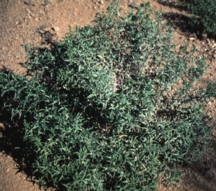

Genus: Ambrosia
Species: deltoidea

Triangle-leaf bursage is a native plant of the Sonoran Desert and can be found throughout southwestern Arizona, USA, south into Sonora and Baja California, Mexico.
Triangle-leaf bursage can be found growing in upper and lower bajadas, lowland creosote growths and desert grasslands. It grows at altitudes of 1,000 to 3,000 feet on open flat, spaces, and steep, gravely hillsides. Triangle-leaf bursage prefers to grow in coarse soils with a high pH where rain percolates quickly and drains away. It is the dominant plant in the Upland Subdivision of the Sonoran Desert where it gets two rainy seasons. It is found growing with palo verde, mesquite, ironwood and mixed varieties of cacti.
Triangle-leaf bursage is a small, round shrub about 1 1/2 feet tall and 2 feet wide. It has many slender and brittle branches that grow from the base to create a dome-like crown. The crown contains many old, dead growth.
Young branches and leaves are hairy and resinous, but become smooth with age. The triangle shaped leaves are about 1 inch long and 1/2 inch wide. The margins are serrated but can sometimes be smooth. They have a gray-green color on top and are white and fuzzy underneath. Triangle-leaf bursage is drought deciduous and will lose its leaves during the dry seasons.
Triangle-leaf bursage has small, 1/4 inch wide yellow-green flowers without petals. They grow in pairs from the end of growth spikes and flower from February to July. Bursage gets its name from its burr-like seeds. The round seeds are covered with hook-tipped spines that attach themselves to the fur of passing animals. The plants produce many seeds after both summer and winter rains.
For a desert plant it has a short life-span, only 50 years. Its most significant function is as a "nurse plant" for other species. Because it prefers to grow in open, sunny areas, it is one of the first plants to populate an empty space too hot for other seedlings. Once it is established, it provides a microhabitat for the seedlings of other species and protects them from herbivores with its tangle of branches. In time the area becomes populated with many different species of desert plants.

Triangle-leaf bursage is well adapted to desert life. Because of its long taproot and well-developed lateral roots it can survive with very little precipitation. During droughts the tiny rootlets that grow on the main root system after it rains die off. When it grows among creosote bush and jumping cholla, bursage has a very distinct root zone. No other plant will grow near triangle bursage roots, cutting down the competition.
The triangle-leaf bursage is a member of the Sunflower family and a cousin of common ragweed.
2002
Bibliography:
"Ambrosia deltoidea", http://www.fs.fed.us/database/feis/plants/shrub/ambdel/
"Master Plant Description", http://www.mswn.com/MSWNmasterplantlist%20A.htm#Ambrosia%20 deltoidea
"Triangle Leaf Bursage Description", http://www.scenicdrive.org/pdbur.htm